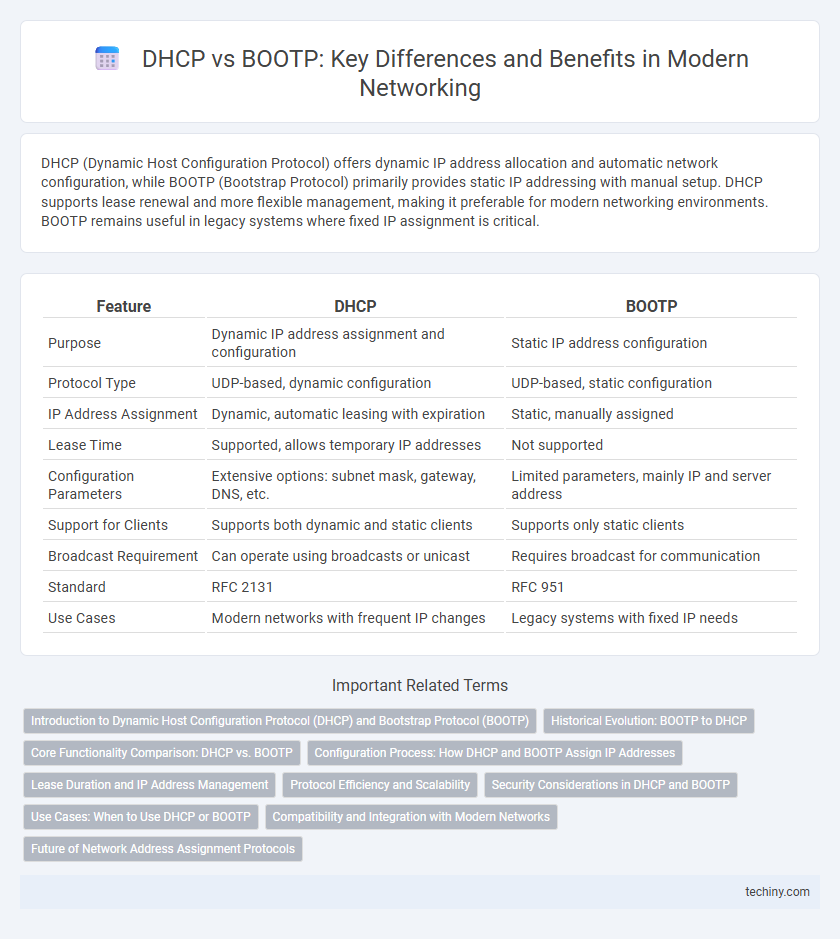DHCP (Dynamic Host Configuration Protocol) offers dynamic IP address allocation and automatic network configuration, while BOOTP (Bootstrap Protocol) primarily provides static IP addressing with manual setup. DHCP supports lease renewal and more flexible management, making it preferable for modern networking environments. BOOTP remains useful in legacy systems where fixed IP assignment is critical.
Table of Comparison
| Feature | DHCP | BOOTP |
|---|---|---|
| Purpose | Dynamic IP address assignment and configuration | Static IP address configuration |
| Protocol Type | UDP-based, dynamic configuration | UDP-based, static configuration |
| IP Address Assignment | Dynamic, automatic leasing with expiration | Static, manually assigned |
| Lease Time | Supported, allows temporary IP addresses | Not supported |
| Configuration Parameters | Extensive options: subnet mask, gateway, DNS, etc. | Limited parameters, mainly IP and server address |
| Support for Clients | Supports both dynamic and static clients | Supports only static clients |
| Broadcast Requirement | Can operate using broadcasts or unicast | Requires broadcast for communication |
| Standard | RFC 2131 | RFC 951 |
| Use Cases | Modern networks with frequent IP changes | Legacy systems with fixed IP needs |
Introduction to Dynamic Host Configuration Protocol (DHCP) and Bootstrap Protocol (BOOTP)
Dynamic Host Configuration Protocol (DHCP) automates IP address allocation and network configuration for devices within a network, enhancing flexibility and reducing manual setup. Bootstrap Protocol (BOOTP), an older protocol, provides fixed IP address assignment and basic configuration primarily for diskless workstations during boot-up. DHCP extends BOOTP's capabilities by supporting dynamic address leasing and additional configuration options, enabling efficient network management.
Historical Evolution: BOOTP to DHCP
BOOTP (Bootstrap Protocol) was developed in the early 1980s to enable diskless workstations to obtain IP addresses and boot information from a server, laying the foundation for automated network configuration. DHCP (Dynamic Host Configuration Protocol) emerged later as an extension of BOOTP, introducing dynamic IP address allocation and lease management to enhance network scalability and flexibility. This evolution from BOOTP to DHCP reflects significant advancements in automated network management and resource optimization.
Core Functionality Comparison: DHCP vs. BOOTP
DHCP (Dynamic Host Configuration Protocol) automates IP address allocation, subnet mask, gateway, and DNS configurations dynamically, while BOOTP (Bootstrap Protocol) primarily provides static IP address assignment based on a device's MAC address. DHCP supports lease time renewal and efficient IP reuse, enabling scalable network management, whereas BOOTP requires manual configuration updates and lacks lease management. The dynamic nature of DHCP offers enhanced flexibility and reduced administrative overhead compared to the static, less adaptable approach of BOOTP.
Configuration Process: How DHCP and BOOTP Assign IP Addresses
DHCP assigns IP addresses dynamically using a lease mechanism that allows devices to receive temporary addresses based on availability, improving network efficiency. BOOTP assigns static IP addresses to devices through a manual configuration stored in a server's database, requiring predefined mappings. DHCP's automated configuration process reduces administrative overhead compared to BOOTP's fixed assignment approach.
Lease Duration and IP Address Management
DHCP provides dynamic IP address management with configurable lease durations, allowing devices to obtain and renew IP addresses for a specified period, ensuring efficient utilization of IP resources. BOOTP, an older protocol, assigns static IP addresses without lease expiration, requiring manual management by network administrators. The lease duration feature in DHCP supports flexible address allocation and enhances network scalability compared to BOOTP's fixed assignment method.
Protocol Efficiency and Scalability
DHCP enhances protocol efficiency by automatically managing IP address allocation with dynamic lease times, reducing manual configuration and network conflicts compared to BOOTP's static assignments. DHCP supports scalability through its centralized management and ability to serve large networks by handling numerous clients simultaneously, while BOOTP's lack of dynamic addressing limits its adaptability in expanding environments. These features make DHCP more suitable for modern, growing networks requiring efficient resource allocation and flexible IP management.
Security Considerations in DHCP and BOOTP
DHCP implements stronger security measures than BOOTP by supporting authentication mechanisms such as DHCP Authentication (RFC 3118), which helps prevent unauthorized IP address allocation and network access. BOOTP lacks built-in security features, making it vulnerable to IP spoofing and unauthorized configurations since it relies on static mappings without authentication. Networks prioritizing secure IP address management should prefer DHCP due to its enhanced protocols for mitigating risks associated with rogue servers and unauthorized clients.
Use Cases: When to Use DHCP or BOOTP
DHCP is ideal for dynamic IP address allocation in modern networks requiring automatic, efficient management of IP leases and configurations. BOOTP suits legacy systems or environments needing fixed IP assignments and basic initialization without frequent reassignment. Use DHCP for scalable, flexible networks and BOOTP in stable, static setups with minimal administrative overhead.
Compatibility and Integration with Modern Networks
DHCP offers superior compatibility with modern network infrastructures by supporting dynamic IP address allocation, automatic lease renewal, and integration with DNS, which BOOTP lacks. Most contemporary network devices and operating systems are designed to seamlessly work with DHCP, ensuring better interoperability and easier network management. While BOOTP remains functional in legacy systems, its static configuration approach limits integration with today's scalable and flexible network environments.
Future of Network Address Assignment Protocols
Dynamic Host Configuration Protocol (DHCP) evolves as the dominant network address assignment protocol, offering enhanced flexibility and support for dynamic IP address allocation compared to the legacy Bootstrap Protocol (BOOTP). Future network address assignment protocols will likely integrate DHCP's automated configuration capabilities with improved security measures, such as IP address authentication and encryption, to address emerging challenges in large-scale, heterogeneous networks. Development trends emphasize scalability and compatibility with IPv6, enabling seamless network management across diverse environments and IoT deployments.
DHCP vs BOOTP Infographic

 techiny.com
techiny.com